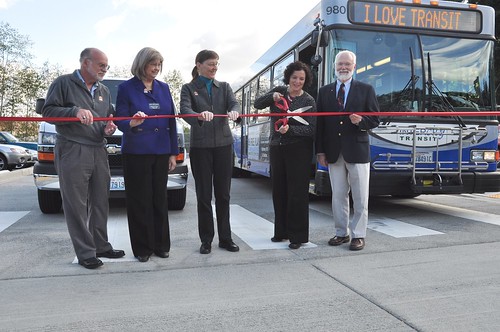Transit grants out the federal door, but what about the cuts?
 |
| Park and Ride Ribbon Cutting Originally uploaded by WSDOT |
Secretary of Transportation Ray LaHood is (rightfully) touting the great news on his blog this morning that the Federal Transit Administration met their ambitious deadline for distributing 100% of the transit funds from the stimulus package. That’s great news, but it should be accompanied by the sobering reminder that these public transportation systems that get people to work each day largely couldn’t use that money to keep from having to cut service at a time when it’s needed the most.
The FTA has now doled out 881 grants totaling $7.5 billion since the stimulus was signed last year, and LaHood notes that these grants have funded the purchase of nearly 12,000 buses, vans and rail vehicles; construction or renovation of more than 850 transit facilities; and $620 million in preventive maintenance to keep systems running smoothly.
But what about the hundreds of agencies cutting back service, raising fares, or laying off workers — like the terrible story from Atlanta we chronicled last Friday, where 25-30% of all service may be history come June?
Unfortunately, the FTA’s hands were tied with the rules for the grants set by Congress, which meant that almost all of the money had to be used to purchase new equipment or perform maintenance, even if those agencies couldn’t afford to hire or train the new drivers to operate the buses or railcars. We say “most of the money,” because a group of lawmakers were able to successfully include a provision in a separate bill during the summer that made it possible for local transit agencies to spend up to 10% of their transit stimulus money on operations. But in many places like St. Louis, where the deficit was ten times the $4.6 million they could now spend on service, that’s not enough to keep from having to make drastic cuts or lay workers off, even while getting an influx of federal money.
With a full transportation bill likely months away, in the short term we need to urge the Senate to include money in any future jobs bills to help keep transit systems running.
With millions who depend on these systems each day to get to work, making sure that reliable transit service doesn’t disappear will help get them to their jobs quickly and conveniently each day, ensuring that many of them stay employed.




















Pingback: More Transit Projects, But Less Service For Region | Mobilizing the Region